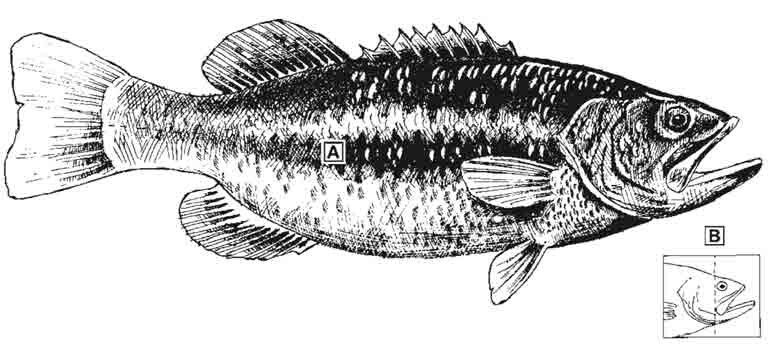Fish Identification
All information below is based from the Texas Parks & Wildlife Department.
Identifying fish correctly is an important aspect of fishing and can lead to hefty fines if wrongly identified by an angler when keeping fish.
Bass Identification
Artwork courtesy Texas Parks and Wildlife Department © 2004
Guadalupe, Alabama and Spotted Bass
A: Irregular lateral stripe is similar to, but more broken than in largemouth bass.
B: Jaw does not extend beyond the back margin of the eye when mouth is closed.C: Spots on scales form "rows" of stripes on whitish belly area.
Artwork courtesy Texas Parks and Wildlife Department © 2004
Largemouth Bass
A: Definite lateral stripe
B: Jaw extends well behind the back margin of the eye when mouth is closed.
Artwork courtesy Texas Parks and Wildlife Department © 2004
Smallmouth Bass
A: Vertical barring along the sides.
B: Jaw does not extend beyond the back margin of the eye when mouth is closed.
C: Brownish-green color; white belly area does not extend high on the sides.
Artwork courtesy Texas Parks and Wildlife Department © 2004
Yellow Bass
A: Stripes distinct, broken above anal fin
B: Color - silvery yellow
C: Dorsal fins joined
D: Does not have a tooth patch near the midline towards the back of the tongue
Artwork courtesy Texas Parks and Wildlife Department © 2004
White Bass
A: Stripes faint, only one extends to tail
B: Body deep, more than 1/3 length
C: Has one tooth patch near the midline towards the back of the tongue
Artwork courtesy Texas Parks and Wildlife Department © 2004
Striped Bass
A: Stripes distinct, several extend to tail
B: Body slender, less than 1/3 length
C: Has two, distinct tooth patches near the midline towards the back of the tongue
Artwork courtesy Texas Parks and Wildlife Department © 2004
Hybrid Striped Bass (AKA Palmetto or Sunshine Bass.)
A: Stripes distinct, usually broken, several extend to tail
B: Body deep, more than 1/3 length
C: Has two tooth patches near the midline towards the back of the tongue. Tooth patches may be distinct or close together.
Note: For hybrids, all characteristics should be considered in combination, as characteristics in individual fish may vary.
Artwork courtesy Texas Parks and Wildlife Department © 2004
Blue Catfish (Ictalurus furcatus)
A: Body without dark spots
B: Outer margin of anal fin straight, and anal fin with 30 to 36 rays
Artwork courtesy Texas Parks and Wildlife Department © 2004
Channel Catfish (Ictalurus punctatus)
A: Body with dark spots (spots may be absent in large adults)
B: Outer margin of anal fin rounded, and anal fin with 24 to 29 rays









